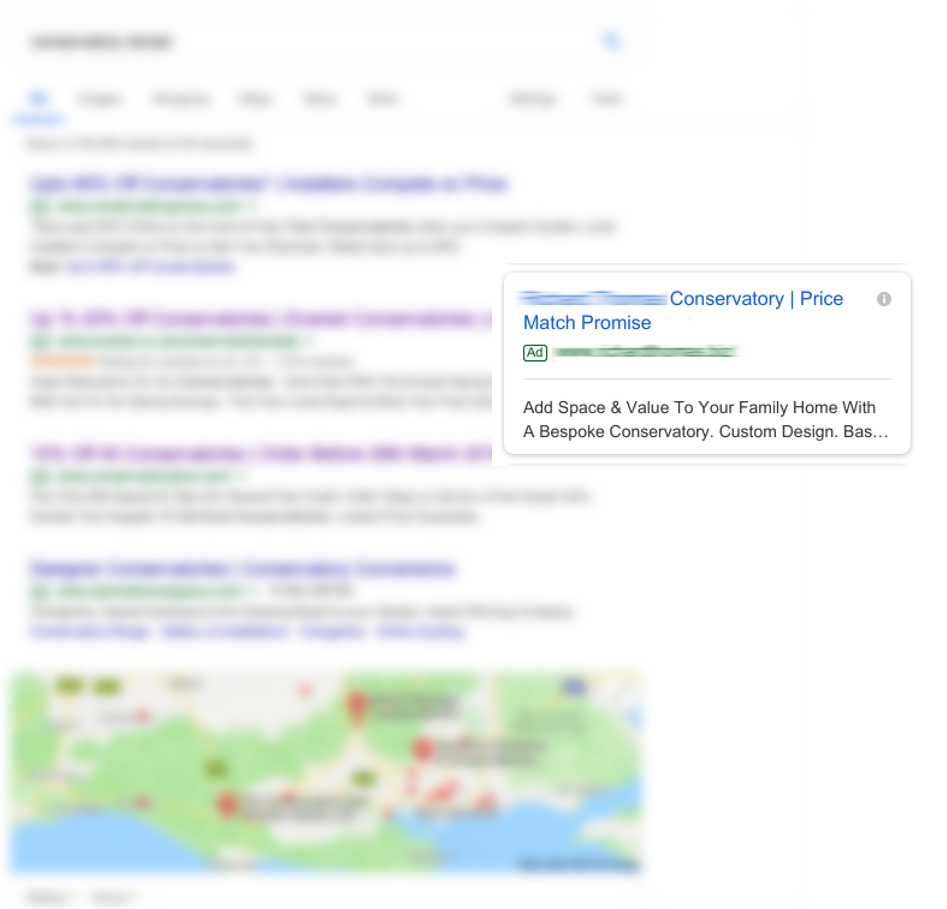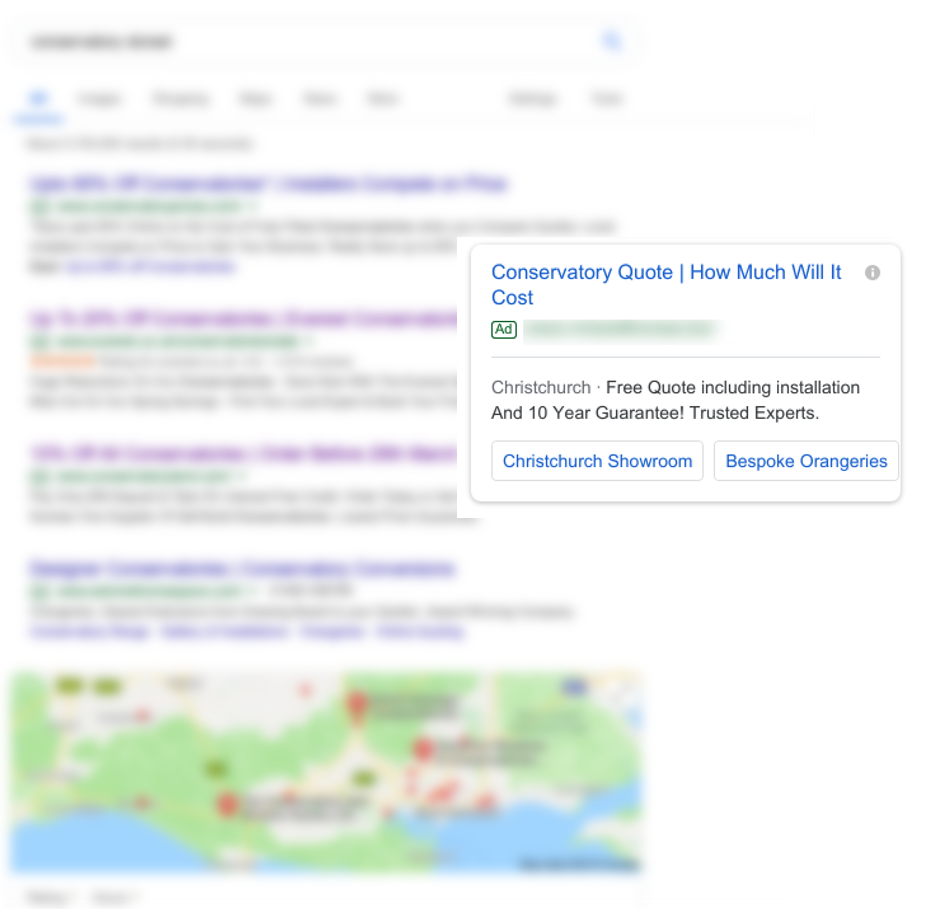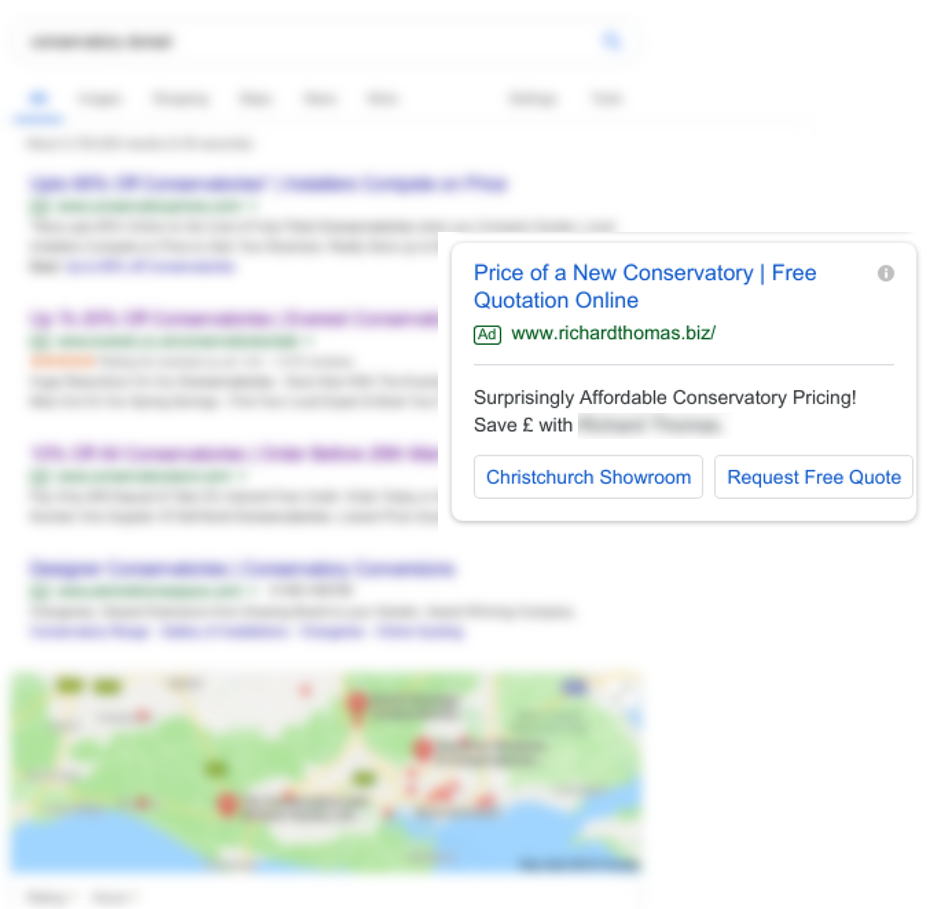We teamed up with a local Conservatory Specialist to improve their PPC results, applying best practices and a little elbow grease to increase inbound leads without increasing the budget.
We’ve been working with a number of different Conservatory Specialists recently and time-and-time again, we run into similar concerns when we inherit their PPC accounts. Adjusting just 5 aspects of these accounts ensures we can get them up to speed and experiencing industry beating results. After taking a look at these PPC campaigns, We usually see:
- An increase in Quality Score by over 50%
- Increase in the average CTR (Click-Through-Rate) from as low as 0.2% to as high as 6.8%.
- Reduction in Landing page bounce rate by as much as 90%.
These stats are fairly tasty – especially if we’re dealing with sizeable click-budgets but even on smaller accounts, each percentage increase could represent a handful of new inbound enquiries. Certainly, something not to be sniffed at!
Now specifically, which aspects do we look at which can result in such splendid results?
1: Build A Strong Account Structure
Like your home, having firm foundations helps a lot. With a PPC campaign the same rule applies; here are the first few items I look at are:
- The volume of keywords in each of the ad groups.
- How many adverts are allocated in each ad group.
- How relevant are the keywords to one-another and the ads within each group.
With the majority of Conservatory Specialists extremely excited about getting started with their PPC adventures, you usually discover that they’ve either jumped into it and quickly jammed out some vague keyword structures and connected up some uninspired adverts or paid an agency too little and received the same result.
One of the specialists we currently work with actually had quite a well thought out structure but there was (there always is) some room for improvement. There were tightly themed ad groups (perfect) – for example, they had one based around aluminium orangeries and another focused-on gable ended conservatories and so on but importantly the majority of their ad groups are under one campaign. With more organisation and relevancy throughout the account, we had the ability to truly hone in on specific areas of the business and capture more qualified traffic that is more likely to convert.
Fundamentally, it’s always best to have a number of campaigns focused around each product, location or other themes that make sense for your particular business objectives. Looking at your business website could present a great way of structuring your campaigns – think product categories, ranges or service areas.
Having more than a couple of campaigns might not make sense for your business – If your budget is small, it may stretch it so far that it makes little impact. Instead, you may want to hedge your bets by establishing a main campaign (which you give 80% of your budget) and a secondary/alternative campaign (which takes 20%).
Looking further into this conservatory account, it was also clear there were a few different ways we could further break down the account structure. For example, we could create a different campaign for Conservatories, Orangeries, Extensions & Windows & Doors, and then have ad groups for the different products in each campaign. This gives us the freedom to get rather granular (which is great for improving quality scores and reducing the cost-per-click).
For Example:
Category:
- Conservatories
Ad Groups:
- Victorian Conservatory
- Gable End Conservatory
- Lean-to Conservatory
- Edwardian Conservatory
Within each of these ad groups, we want to have super tightly themed keywords relating to that ad group. Google themselves propose not having more 30 keywords per ad group and then having two or three adverts for each ad group. Ideally, the keywords, ads and landing pages should all be extremely relevant to one another, since the user/searcher will be far more likely to express genuine interest.
An example could be that if you were searching for Gable End Conservatory but then redirected to an ad rambling on about the virtues of Aluminium windows, would you click? Likely not, because the product is irrelevant to your interest (the thing you searched for). Additionally, if the ad did display text reading ‘Get a quote for a Gable End Conservatory’ but you were then directed to a landing page about ‘Edwardian style Conservatories’, you’d be disappointed and leave quickly. As you can see, relevancy and taking some time to think about the searchers intent are both extremely powerful and important factors in improving results.
2: Focus on High-Performance PPC Keywords
What are the signals that a keyword is high performing? It all depends on your goals and which Key Performance Indicators are important to you and your business. For our Conservatory Specialist, they identified that click-through-rate and conversions are two very important statistics to determine is the campaigns are successful.
With this set, we jumped into the historical performance of the existing keywords of the campaign to see which keywords stood above the rest. The keyword ‘Cornwall conservatory quote’ had a great click-through-rate of 7.4%, Quality Score of 8 and lots of conversions. What a great find! Just this one keyword was really leading the way for these guys.
What did this show us? A few things actually – maybe we want to establish a whole ad group just around ‘Cornwall conservatory quote’. This would allow us to focus in on this super-rockstar keyword and get even more conversions and business from it. In the new ad group, our Conservatory Specialist, will want some variations of the keyword as well to create some relevant ads that are super-specific to that keyword. So, the headline would read something like ‘Our Unbeatable Cornwall Conservatory Quotes’ or ‘The Best Conservatory Quote in Cornwall’.
Typically, when you’ve identified a super valuable keyword, you probably want to use a tiered bidding strategy on that word. For those uninitiated, Tiered bidding is where you bid on the same keyword with all four match types. The more restrictive you get with the match type, the more you’ll want to bid because the quality of traffic will increase.
For example, we might want to bid on ‘cheap conservatories price’ like the following.
Exact: £20 CPC
Phrase: £15 CPC
Modified Broad: £10 CPC
Broad: £5
Ok, so why would you bid the highest on Exact Match? The Return is typically better because you are bidding on the precise term potential customers would use and because you already know this, we can be confident that those using this keyword will buy more frequently than those using a different term. With Broad Match, we bid less because this may capture searchers who include additional words – additional words which make the search term less interesting for us and less likely to convert e.g. ‘cheap conservatories price rubbish’ or ‘cheap conservatories price racist’. Also, because the Broad Match will capture a vast range of search terms/keywords, the volume will be higher which will also result in more clicks – reducing our bid, protects us from being charged a fortune for high click rates for worthless leads.
3: Further Build Out Negative Keyword Lists
Negative keywords. The list that can make or break a campaign. Building out and monitoring your negative keyword lists will help significantly reduce costs and improve results – it’s actually crucial if you’re using Broad match types. It’s fairly simple to waste all your budget on bad matches and there isn’t a way to claw that back from Google so not spending your budget on bad keywords is fundamental. If negatives are not setup properly, buyer beware.
Our Conservatory Specialist used a fair amount of broad match and modified broad match keywords so this was a rea of focus for us – something which we’ve continued to include with our strategies moving forward but only in a more controlled approach.
Really, the most effective way to identify negatives is of course by looking at what people are actually typing into Google which trigger your ads. Fortunately, our team have a full (very expensive) toolset to use for finding this information out. Our toolset can actually uncover search query data that be used to identify and set up a single word or multiple word negative or suggest keywords to include that might be worth bidding on – it can even show us clumps of keywords which we should build ad groups around. Very useful, hugely valuable.
Jumping into our toolset in more detail for our Conservatory Specialist, we were able to identify several negative keywords when reviewing ‘aluminium gable end conservatory’. It was getting steady 20 clicks per month but represented a service which the business simply didn’t offer – so any clicks it does receive, sucks money out of the business and returns nothing but disappointment. Therefore, we added it to the negative list so that we don’t show ads when it’s searched.
Now, keep in mind that it’s also really important to make sure that your negatives don’t block other terms that you are interested in. Using the above example, if we added ‘aluminium gable end conservatory’ as a broad match in our negative list, searches for ‘gable end conservatory’ would also be blocked. Be careful what you block. Seriously.
4: Pause Keywords with Poor Performance
First bit – How do you know if one of your keywords is suffering from poor performance?
Data is going to lead the way here. Make sure your campaign has been running long enough to acquire enough data to make a decision. If a keyword has only been running for a few days or has next to no clicks, leave it running and kick the decision further down the road. You need enough clicks, visits and conversions to make an informed decision – if 100 people clicked on your keyword and only 2 converted, does this give us enough information to decide whether it worked or not?
Homework isn’t just for kids. You’ll need to investigate to find out why the keyword is not performing well. A few situations I usually come across are:
The keyword has low search volume. If the keyword is not collecting much traffic even though your bid is sufficient enough, the actual keyword ay be too long-tailed or simply a phrase that users are never searching for. It’s recommended that the keyword is paused to de-clutter your account. It’s also important to pause keywords that are getting lots of impressions but very few or hardly any clicks as this will hurt your Click Through Rate and Quality Score. Following our advice, our Conservatory Specialist paused the ‘gable end’ keyword because it received over 2,000 impressions but only 1 click, resulting in a 0.2% CTR. Likely the keyword was too general and was therefore underperforming, hurting their account so it was the smart move to pause the keyword.
The keyword’s bid is not high enough. Take a quick glance at the #1 CPC and the top of page bid estimate to ensure your bids are competitive enough. Our Conservatory Specialist was bidding a penny on a variety of keywords; in this situation increasing the CPC bids yielded lots more traffic and higher opportunity to convert.
The match type if either too broad or too restrictive. If the volume for the keyword is high but the Click-through-rate or Conversions are really/super low on a broad keyword, then pause it and add the keyword with a more restrictive match type. In this campaign, there was a keyword ‘conservatory quote glass’ which was on an exact match which resulted in an exceptionally low click-through-rate. Updating the type to Broad introduced more searches, resulting in more clicks and conversions. Sometimes it takes a little space for search terms to breath and be found.
5: Optimize Ads & Create New Ad Text
The aim of the game is to be continuously optimising your ad text. If you’re not optimising, you’ll be progressively getting worse results. If your ads aren’t compelling or relevant (see above) to your keywords, searchers won’t be clicking on them, resulting in less traffic to your site.
By testing and tweaking your ad copy to improve your PPC performance you’ll be following best-practices. Are you having a Summer sale? Perhaps you’re starting a one-off discount event? Include wording to encapsulate your offer in your ad text! If our Conservatory Specialist wanted to offer a 40% discount on specific conservatories during the slow months, this should be expressed in the ad text.
Our Conservatory Specialist ads have great historical performance with lots of impressions and high-click-through-rates. Here are a few extra tips which you can take away from their successful campaign’s ad copy.
They do a great job of relevancy.
Take a look at this one –
This Conservatory Specialist ad group is designed to capture leads and bring them to the homepage of their website and this is done by using keywords like ‘conservatory Dorset’ or ‘conservatory quote’ etc. The keywords here are highly relevant to the ads they have written and results in a very high CTR (Click-Through-Rate).

They also use Ad variants.
In each ad group, I typically suggest that you run two ads for desktop and two ads for mobile at the same time to test which one performs better. These guys have done just that and is able to easily compare performance between the ads. For example, we saw that using ‘cheap quote’ in their ads led to worse quality leads so we decided to tweak the wording to improve performance. You can try varying your advert’s title, punctuation and a variety of unique selling propositions.
They also have a sitelink extension enabled.
Sitelinks extend the presence of the original advert copy, taking up more screen real-estate increasing the chances of the advert being seen. Valuable sitelinks such as Conservatories, Extensions or Quick Quote increased click-through-rates by 60% in some cases. Using Sitelinks just makes it easier for potential customers to drill into the most relevant page – even if the copy may not be 100% accurate for their chosen search terms.

conservatory pcc campaign optimised 2
The ad copy is simple, to the point and includes a clear call to action. For example, ‘get your conservatory quote’. Every ad needs a clear CTA (Call-To-Action) so the searcher knows what the expected action to be taken is before even clicking on the ad. What else can be done here?
There is still room for improved performance within the ad text, including some of the following.
They should add punctuation to the end of the line 1 description. What this does is when the ad appears at the top of the page on the search results, that punctuation mark tells Google to pull the first description line into the headline. This extends the presence of the ad and is proven to increase click-through rates.

We should add a descriptive line to the display URL, for example: www.conservatoryspecialist.com/quote-conservatory
Think of the display URL as yet another opportunity to add context to your ad – an extension of the description of the advertisement.
They could change up the ad copy even more. In one ad group they are using ‘get quick quote conservatory’ in some of the headlines but perhaps they should experiment with ‘get small conservatory quote’ or ‘unbeatable conservatory quote’. Testing more ad text can give a greater test sample, and could improve conversions rates across the board.
All in all, working with this Conservatory Specialist has been an excellent experience and the results are a testament to a truly collaborative effort – sharing expertise between one another has helped design a campaign that applies best practices and specialist conservatory product knowledge.
What is important, is that the campaign is constantly optimised and updated in an effort to find where the improvements can be found. Tweaking Copy, updating Sitemaps or changing up the descriptions are all valuable opportunities to squeeze more results from the same budget.
What are you doing to continuously optimize your Google Ads PPC performance?


